1299 lines
64 KiB
Markdown
1299 lines
64 KiB
Markdown
|
|
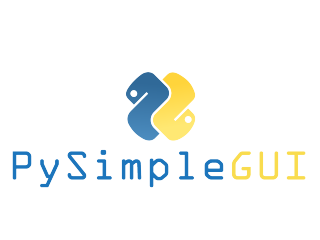
|
|
|
|
[](http://pepy.tech/project/pysimplegui) since Jul 11, 2018
|
|
# PySimpleGUI
|
|
(Ver 2.4)
|
|
|
|
This really is a simple GUI, but also powerfully customizable.
|
|
|
|
|
|
import PySimpleGUI as sg
|
|
|
|
sg.MsgBox('Hello From PySimpleGUI!', 'This is the shortest GUI program ever!')
|
|
|
|
|
|
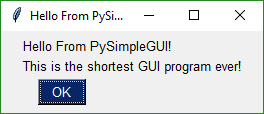
|
|
|
|
Add a Progress Meter to your code with ONE LINE of code
|
|
|
|
EasyProgressMeter('My meter title', current_value, max value)
|
|
|
|
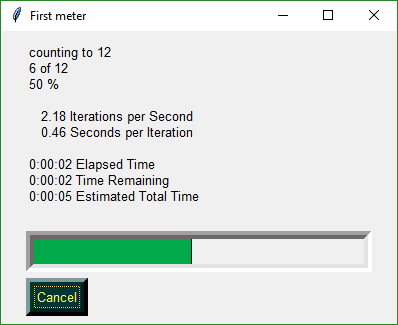
|
|
|
|
Or how about a media player GUI with custom buttons... in 30 lines of code.
|
|
|
|
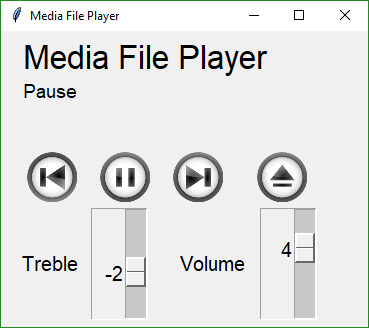
|
|
|
|
I was frustrated by having to deal with the dos prompt when I had a powerful Windows machine right in front of me. Why is it SO difficult to do even the simplest of input/output to a window in Python??
|
|
|
|
There are a number of 'easy to use' Python GUIs, but they're **very** limiting. PySimpleGUI takes the best of packages like `EasyGUI`and `WxSimpleGUI` , both really handy but limited. The primary difference between these and PySimpleGUI is that in addition to getting the simple Message Boxes you also get the ability to make your own forms that are highly customizeable. Don't like the standard Message Box? Then make your own!
|
|
|
|
Every call has optional parameters so that you can change the look and feel. Don't like the button color? It's easy to change by adding a button_color parameter to your widget.
|
|
|
|
GUI Packages with more functionality, like QT and WxPython, require configuring and can take a ***week*** to get *reasonably familiar* with the interfaces. Clearly there needs to be a middle ground between forms with 1 or two input fields and a full-blown GUI. You'll be making your own custom forms with PySimpleGUI within minutes, even Async forms.
|
|
|
|
With a simple GUI, it becomes practical to "associate" .py files with the python interpreter on Windows. Double click a py file and up pops a GUI window, a more pleasant experience than opening a dos Window and typing a command line.
|
|
|
|
The `PySimpleGUI` package is focused on the ***developer***. How can the desired result be achieved in as little and as simple code as possible? This was the mantra used to create PySimpleGUI. How can it be done is a Python-like way?
|
|
|
|
Features of PySimpleGUI include:
|
|
Text
|
|
Single Line Input
|
|
Buttons including these types:
|
|
File Browse
|
|
Folder Browse
|
|
Non-closing return
|
|
Close form
|
|
Checkboxes
|
|
Radio Buttons
|
|
Listbox
|
|
Slider
|
|
Icons
|
|
Multi-line Text Input
|
|
Scroll-able Output
|
|
Images
|
|
Progress Bar
|
|
Async/Non-Blocking Windows
|
|
Tabbed forms
|
|
Persistent Windows
|
|
Redirect Python Output/Errors to scrolling window
|
|
'Higher level' APIs (e.g. MessageBox, YesNobox, ...)
|
|
Single-Line-Of-Coide Proress Bar & Debug Print
|
|
|
|
|
|
An example of many widgets used on a single form. A little further down you'll find the TWENTY lines of code required to create this complex form. Try it if you don't believe it. Copy and paste into a temp file and it'll run, presenting you with the screen you see.
|
|
|
|
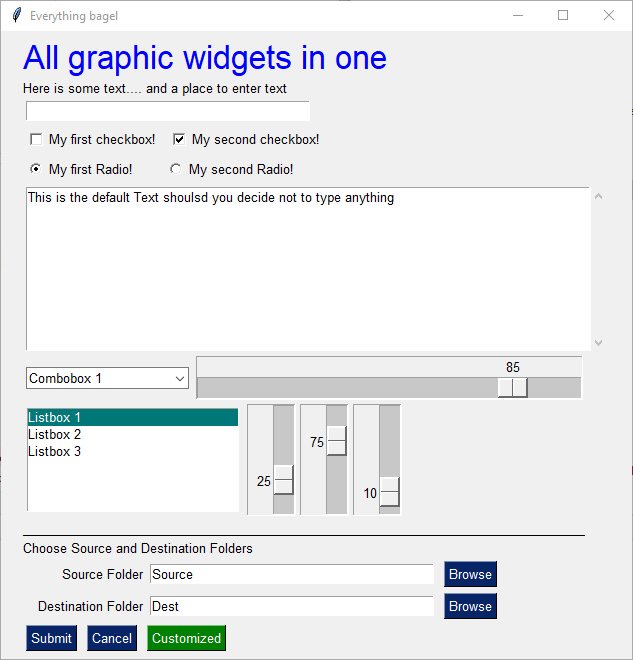
|
|
|
|
Here is the code that produced the above screenshot.
|
|
|
|
import PySimpleGUI as SG
|
|
|
|
with SG.FlexForm('Everything bagel', auto_size_text=True, default_element_size=(40, 1)) as form:
|
|
layout = [
|
|
[SG.Text('All graphic widgets in one form!', size=(30, 1), font=("Helvetica", 25), text_color='blue')],
|
|
[SG.Text('Here is some text.... and a place to enter text')],
|
|
[SG.InputText()],
|
|
[SG.Checkbox('My first checkbox!'), SG.Checkbox('My second checkbox!', default=True)],
|
|
[SG.Radio('My first Radio! ', "RADIO1", default=True), SG.Radio('My second Radio!', "RADIO1")],
|
|
[SG.Multiline(default_text='This is the default Text shoulsd you decide not to type anything',
|
|
scale=(2, 10))],
|
|
[SG.InputCombo(['Combobox 1', 'Combobox 2'], size=(20, 3)),
|
|
SG.Slider(range=(1, 100), orientation='h', size=(35, 20), default_value=85)],
|
|
[SG.Listbox(values=['Listbox 1', 'Listbox 2', 'Listbox 3'], size=(30, 6)),
|
|
SG.Slider(range=(1, 100), orientation='v', size=(10, 20), default_value=25),
|
|
SG.Slider(range=(1, 100), orientation='v', size=(10, 20), default_value=75),
|
|
SG.Slider(range=(1, 100), orientation='v', size=(10, 20), default_value=10)],
|
|
[SG.Text('_' * 100, size=(70, 1))],
|
|
[SG.Text('Choose Source and Destination Folders', size=(35, 1))],
|
|
[SG.Text('Source Folder', size=(15, 1), auto_size_text=False, justification='right'), SG.InputText('Source'), SG.FolderBrowse()],
|
|
[SG.Text('Destination Folder', size=(15, 1), auto_size_text=False, justification='right'), SG.InputText('Dest'),
|
|
SG.FolderBrowse()],
|
|
[SG.Submit(), SG.Cancel(), SG.SimpleButton('Customized', button_color=('white', 'green'))]
|
|
]
|
|
|
|
button, values = form.LayoutAndRead(layout)
|
|
|
|
**A note on screen shots**
|
|
You will see a number of different styles of buttons, data entry fields, etc, in this readme. They were all made with the same SDK, the only difference is in the settings that are specified on a per-element, row, form, or global basis. One setting in particular, border_width, can make a big difference on the look of the form. Some of the screenshots had a border_width of 6, others a value of 1.
|
|
|
|
|
|
---
|
|
### Design Goals
|
|
> Copy, Paste, Run.
|
|
|
|
`PySimpleGUI's` goal with the API is to be easy on the programmer, and to function in a Python-like way. Since GUIs are visual, it was desirable for the SDK to visually match what's on the screen.
|
|
|
|
Be Pythonic... Python's lists in particular worked out really well:
|
|
- Forms are represented as Python lists.
|
|
- A form is a list of rows
|
|
- A row is a list of elements
|
|
- Return values are a list
|
|
|
|
Each Elements is specified by names such as Text, Button, Checkbox, etc.
|
|
|
|
Some elements have shortcuts, meant to make it easy on the programmer who will write less code using them. Rather than writing calling `Button`, with `button_name = "Submit"` will create a button with the text 'Submit' on it, Other examples include shortening the name of the function. `Text` is shorted to `Txt` or `T`. See each API call for the shortcuts.
|
|
|
|
-----
|
|
## Getting Started with PySimpleGUI
|
|
|
|
### Installing
|
|
|
|
pip install PySimpleGUI
|
|
or
|
|
Simply download the file - PySimpleGUI.py and import it into your code
|
|
|
|
|
|
### Prerequisites
|
|
|
|
Python 3
|
|
tkinter
|
|
|
|
Should run on all Python platforms that have tkinter running on them. Has been thoroughly tested on Windows. While not tested elsewhere, should work on Linux, Mac, Pi, etc.
|
|
|
|
### Using
|
|
|
|
To use in your code, simply import....
|
|
`import PySimpleGUI as SG`
|
|
|
|
Then use either "high level" API calls or build your own forms.
|
|
|
|
SG.MsgBox('This is my first message box')
|
|
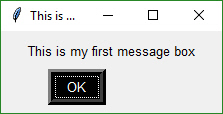
|
|
|
|
Yes, it's just that easy to have a window appear on the screen using Python. With PySimpleGUI, making a custom form appear isn't much more difficult. The goal is to get you running on your GUI within ***minutes***, not hours nor days.
|
|
|
|
---
|
|
## APIs
|
|
|
|
PySimpleGUI can be broken down into 2 types of API's:
|
|
* High Level single call functions
|
|
* Custom form functions
|
|
|
|
|
|
### Python Language Features
|
|
|
|
There are a couple of Python language features that PySimpleGUI utilizes heavily that should be understood first...
|
|
* Variable number of arguments to a function call
|
|
* Optional parameters to a function call
|
|
|
|
#### Variable Number of Arguments
|
|
|
|
The "High Level" API calls that *output* values take a variable number of arguments so that they match a "print" statement as much as possible. The idea is to make it simple for the programmer to output as many items as desired and in any format. The user need not convert the variables to be output into the strings. The PySimpleGUI functions do that for the user.
|
|
|
|
SG.MsgBox('Variable number of parameters example', var1, var2, "etc")
|
|
|
|
Each new item begins on a new line in the Message Box
|
|
|
|
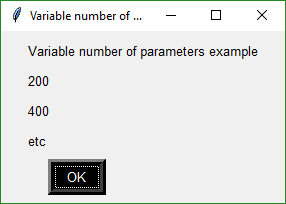
|
|
|
|
|
|
#### Optional Parameters to a Function Call
|
|
|
|
This feature of the Python language is utilized ***heavily*** as a method of customizing forms and form Elements. Rather than requiring the programmer to specify every possible option for a widget, instead only the options the caller wants to override are specified.
|
|
|
|
Here is the function definition for the MsgBox function. The details aren't important. What is important is seeing that there is a long list of potential tweaks that a caller can make. However, they don't *have* to be specified on each and every call.
|
|
|
|
def MsgBox(*args,
|
|
button_color=None,
|
|
button_type=MSG_BOX_OK,
|
|
auto_close=False,
|
|
auto_close_duration=None,
|
|
icon=DEFAULT_WINDOW_ICON,
|
|
line_width=MESSAGE_BOX_LINE_WIDTH,
|
|
font=None):
|
|
|
|
If the caller wanted to change the button color to be black on yellow, the call would look something like this:
|
|
|
|
SG.MsgBox('This box has a custom button color',
|
|
button_color=('black', 'yellow'))
|
|
|
|
|
|
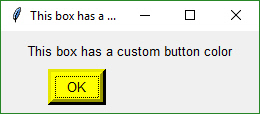
|
|
|
|
|
|
---
|
|
|
|
### High Level API Calls
|
|
|
|
The classic "input a value, print result" example.
|
|
Often command line programs simply take some value as input on the command line, do something with it and then display the results. Moving from the command line to a GUI is very simple.
|
|
This code prompts user to input a line of text and then displays that text in a messages box:
|
|
|
|
import PySimpleGUI_local as SG
|
|
|
|
rc = SG.GetTextBox('Title', 'Please input something')
|
|
SG.MsgBox('Results', 'The value returned from GetTextBox', rc)
|
|
|
|
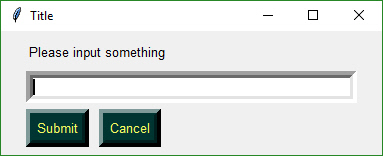
|
|
|
|
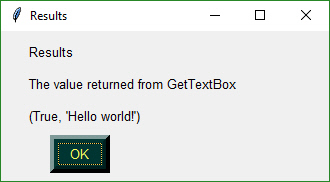
|
|
|
|
#### Message Boxes
|
|
In addition to MsgBox, you'll find a several API calls that are shortcuts to common messages boxes. You can achieve similar results by calling MsgBox with the correct parameters.
|
|
|
|
The differences tend to be the number and types of buttons. Here are the calls and the windows that are created.
|
|
|
|
import PySimpleGUI as SG
|
|
|
|
`SG.MsgBoxOK('This is an OK MsgBox')`
|
|
|
|
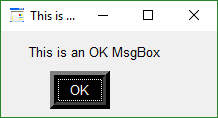
|
|
|
|
SG.MsgBoxOKCancel('This is an OK Cancel MsgBox')
|
|
|
|
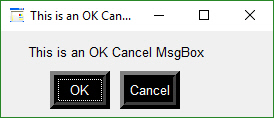
|
|
|
|
SG.MsgBoxCancel('This is a Cancel MsgBox')
|
|
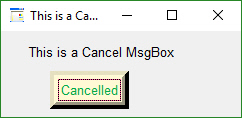
|
|
|
|
SG.MsgBoxYesNo('This is a Yes No MsgBox')
|
|
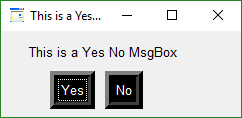
|
|
|
|
SG.MsgBoxError('This is an error MsgBox')
|
|
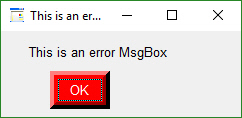
|
|
|
|
SG.MsgBoxAutoClose('This is an autoclose MsgBox')
|
|
|
|
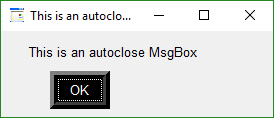
|
|
|
|
SG.ScrolledTextBox(my_text, height=10)
|
|
|
|
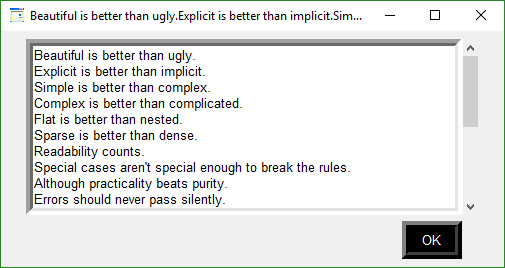
|
|
|
|
Take a moment to look at that last one. It's such a simple API call and yet the result is awesome. Rather than seeing text scrolling past on your display, you can capture that text and present it in a scrolled interface. It's handy enough of an API call that it can also be called using the name `sprint` which is easier to remember than `ScrollectTextBox`. Your code could contain a line like:
|
|
|
|
sprint(f'My variables values include x={x}', f'y={y}')
|
|
|
|
This becomes a debug print of sorts that will route to a scrolled window.
|
|
|
|
#### High Level User Input
|
|
|
|
There are 3 very basic user input high-level function calls. It's expected that for most applications, a custom input form will be created. If you need only 1 value, then perhaps one of these high level functions will work.
|
|
- GetTextBox
|
|
- GetFileBox
|
|
- GetFolderBox
|
|
|
|
`submit_clicked, value = SG.GetTextBox('Title', 'Please enter anything')`
|
|
|
|
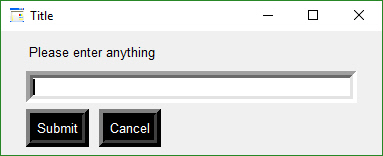
|
|
|
|
submit_clicked, value = SG.GetFileBox('Title', 'Choose a file')
|
|
|
|
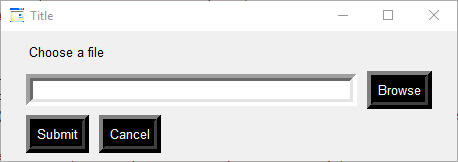
|
|
|
|
submit_clicked, value = SG.GetPathBox('Title', 'Choose a folder')
|
|
|
|
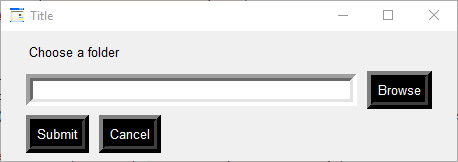
|
|
|
|
#### Progress Meter!
|
|
We all have loops in our code. 'Isn't it joyful waiting, watching a counter scrolling past in a text window? How about one line of code to get a progress meter, that contains statistics about your code?
|
|
|
|
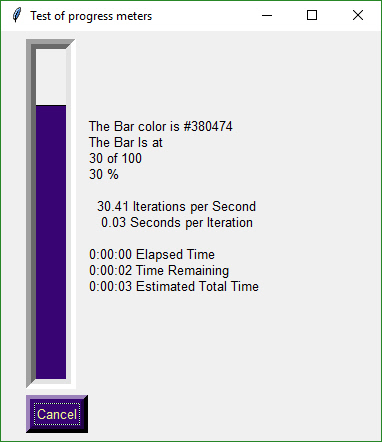
|
|
|
|
|
|
EasyProgressMeter(title,
|
|
current_value,
|
|
max_value,
|
|
*args,
|
|
orientation=None,
|
|
bar_color=DEFAULT_PROGRESS_BAR_COLOR,
|
|
button_color=None,
|
|
size=DEFAULT_PROGRESS_BAR_SIZE,
|
|
scale=(None, None),
|
|
border_width=DEFAULT_PROGRESS_BAR_BORDER_WIDTH):
|
|
|
|
Here's the one-line Progress Meter in action!
|
|
|
|
for i in range(1,10000):
|
|
SG.EasyProgressMeter('My Meter', i+1, 10000, 'Optional message')
|
|
|
|
That line of code resulted in this window popping up and updating.
|
|
|
|
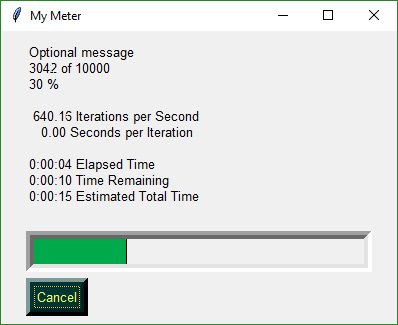
|
|
|
|
A meter AND fun statistics to watch while your machine grinds away, all for the price of 1 line of code.
|
|
With a little trickery you can provide a way to break out of your loop using the Progress Meter form. The cancel button results in a `False` return value from `EasyProgressMeter`. It normally returns `True`.
|
|
|
|
if not SG.EasyProgressMeter('My Meter', i+1, 10000, 'Optional message'):
|
|
break
|
|
|
|
***Be sure and add one to your loop counter*** so that your counter goes from 1 to the max value. If you do not add one, your counter will never hit the max value. Instead it will go from 0 to max-1.
|
|
#### Debug Output
|
|
Another call in the 'Easy' families of APIs is `EasyPrint`. It will output to a debug window. If the debug window isn't open, then the first call will open it. No need to do anything but stick a 'print' call in your code. You can even replace your 'print' calls with calls to EasyPrint by simply sticking the statement
|
|
|
|
print = SG.EasyPrint
|
|
|
|
at the top of your code.
|
|
There are a number of names for the same EasyPrint function. `Print` is one of the better ones to use as it's easy to remember. It is simply `print` with a capital P.
|
|
|
|
import PySimpleGUI as SG
|
|
|
|
for i in range(100):
|
|
SG.Print(i)
|
|
|
|
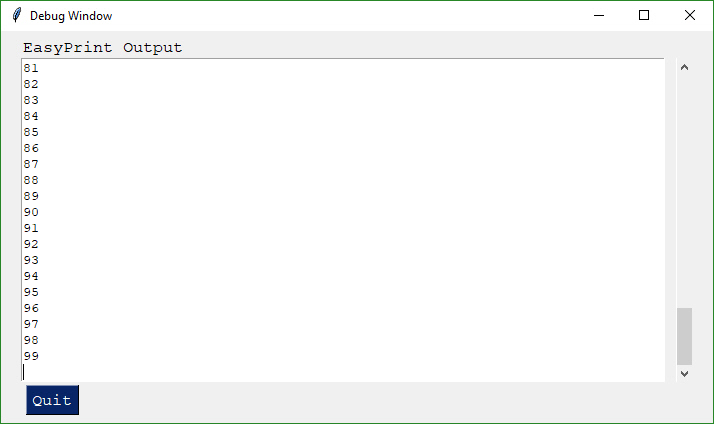
|
|
Or if you didn't want to change your code:
|
|
|
|
import PySimpleGUI as SG
|
|
|
|
print=SG.Print
|
|
for i in range(100):
|
|
print(i)
|
|
|
|
Just like the standard print call, `EasyPrint` supports the `sep` and `end` keyword arguments. Other names that can be used to call `EasyPrint` include Print, `eprint`, If you want to close the window, call the function `EasyPrintClose`.
|
|
|
|
A word of caution. There are known problems when multiple PySimpleGUI windows are opened, particularly if the user closes them in an unusual way. Not a reason to stay away from using it. Just something to keep in mind if you encounter a problem.
|
|
|
|
You can change the size of the debug window using the `SetOptions` call with the `debug_win_size` parameter.
|
|
|
|
---
|
|
# Custom Form API Calls
|
|
|
|
This is the FUN part of the programming of this GUI. In order to really get the most out of the API, you should be using an IDE that supports auto complete or will show you the definition of the function. This will make customizing go smoother.
|
|
|
|
This first section on custom forms is for your typical, blocking, non-persistant form. By this I mean, when you "show" the form, the function will not return until the user has clicked a button or closed the window. When this happens, the form's window will be automatically closed.
|
|
|
|
Two other types of forms exist.
|
|
1. Persistent form - rather than closing on button clicks, the show form function returns and the form continues to be visible. This is good for applications like a chat window.
|
|
2. Asynchronous form - the trickiest of the lot. Great care must be exercised. Examples are an MP3 player or status dashboard. Async forms are updated (refreshed) on a periodic basis.
|
|
|
|
It's both not enjoyable nor helpful to immediately jump into tweaking each and every little thing available to you. Let's start with a basic Browse for a file and do something with it.
|
|
# Copy these design patterns!
|
|
## Pattern 1 - With Context Manager
|
|
|
|
|
|
with sg.FlexForm('SHA-1 & 256 Hash', auto_size_text=True) as form:
|
|
form_rows = [[sg.Text('SHA-1 and SHA-256 Hashes for the file')],
|
|
[sg.InputText(), sg.FileBrowse()],
|
|
[sg.Submit(), sg.Cancel()]]
|
|
button, (source_filename,) = form.LayoutAndRead(form_rows)
|
|
|
|
## Pattern 2 - No Context Manager
|
|
|
|
|
|
form = sg.FlexForm('SHA-1 & 256 Hash', auto_size_text=True)
|
|
form_rows = [[sg.Text('SHA-1 and SHA-256 Hashes for the file')],
|
|
[sg.InputText(), sg.FileBrowse()],
|
|
[sg.Submit(), sg.Cancel()]]
|
|
button, (source_filename,) = form.LayoutAndRead(form_rows)
|
|
|
|
|
|
|
|
These 2 design patters both produce this custom form:
|
|
|
|

|
|
|
|
It's important to use the "with" context manager so that resources are freed as quickly as possible, using the currently executing thread. PySimpleGUI uses `tkinter`. `tkinter` is very picky about who releases objects and when. The `with` takes care of disposing of everything properly for you.
|
|
|
|
The second design pattern is not context manager based. If you are struggling with an unknown error, try modifying the code to run without a context manager. To do so, you simple remove the with, stick the form on the front of that statement, and un-indent the with-block code.
|
|
|
|
You will use these design patterns or code templates for all of your "normal" (blocking) types of input forms. Copy it and modify it to suit your needs. This is the quickest way to get your code up and running with PySimpleGUI. This is the most basic / normal of the design patterns.
|
|
|
|
### Line by line explanation
|
|
|
|
Going through each line of code in the above form will help explain how to use this design patter. Copy, modify and run it!
|
|
|
|
with SG.FlexForm('SHA-1 & 256 Hash', auto_size_text=True) as form:
|
|
This creates a new form, storing it in the variable `form`.
|
|
|
|
form_rows = [[SG.Text('SHA-1 and SHA-256 Hashes for the file')],
|
|
The next few rows of code lay out the rows of elements in the window to be displayed. The variable `form_rows` holds our entire GUI window. The first row of this form has a Text element. These simply display text on the form.
|
|
|
|
[SG.InputText(), SG.FileBrowse()],
|
|
Now we're on the second row of the form. On this row there are 2 elements. The first is an `Input` field. It's a place the user can enter `strings`. The second element is a `File Browse Button`. A file or folder browse button will always fill in the text field to it's left unless otherwise specified. In this example, the File Browse Button will interact with the `InputText` field to its left.
|
|
|
|
[SG.Submit(), SG.Cancel()]]
|
|
|
|
The last line of the `form_rows` variable assignment contains a Submit and a Cancel Button. These are buttons that will cause a form to return its value to the caller.
|
|
|
|
(button, (source_filename, )) = form.LayoutAndRead(form_rows)
|
|
This is the code that **displays** the form, collects the information and returns the data collected. In this example we have a button return code and only 1 input field
|
|
|
|
|
|
|
|
---
|
|
|
|
## Return values
|
|
|
|
Return information from FlexForm, SG's primary form builder interface, is in this format:
|
|
|
|
button, (value1, value2, ...)
|
|
|
|
Each of the Elements that are Input Elements will have a value in the list of return values. You can unpack your GUI directly into the variables you want to use.
|
|
|
|
button, (filename, folder1, folder2, should_overwrite) = form.LayoutAndRead(form_rows)
|
|
|
|
Or, you can unpack the return results separately.
|
|
|
|
button, values = form.LayoutAndRead(form_rows)
|
|
filename, folder1, folder2, should_overwrite = values
|
|
|
|
If you have a SINGLE value being returned, it is written this way:
|
|
|
|
button, (value1,) = form.LayoutAndRead(form_rows)
|
|
|
|
|
|
Another way of parsing the return values is to store the list of values into a variable representing the list of values.
|
|
|
|
button, value_list = form.LayoutAndRead(form_rows)
|
|
value1 = value_list[0]
|
|
value2 = value_list[1]
|
|
...
|
|
|
|
---
|
|
## All Widgets / Elements
|
|
This code utilizes as many of the elements in one form as possible.
|
|
|
|
with SG.FlexForm('Everything bagel', auto_size_text=True, default_element_size=(40, 1)) as form:
|
|
layout = [
|
|
[SG.Text('All graphic widgets in one form!', size=(30, 1), font=("Helvetica", 25), text_color='blue')],
|
|
[SG.Text('Here is some text.... and a place to enter text')],
|
|
[SG.InputText()],
|
|
[SG.Checkbox('My first checkbox!'), SG.Checkbox('My second checkbox!', default=True)],
|
|
[SG.Radio('My first Radio! ', "RADIO1", default=True), SG.Radio('My second Radio!', "RADIO1")],
|
|
[SG.Multiline(default_text='This is the default Text shoulsd you decide not to type anything',
|
|
scale=(2, 10))],
|
|
[SG.InputCombo(['Combobox 1', 'Combobox 2'], size=(20, 3)),
|
|
SG.Slider(range=(1, 100), orientation='h', size=(35, 20), default_value=85)],
|
|
[SG.Listbox(values=['Listbox 1', 'Listbox 2', 'Listbox 3'], size=(30, 6)),
|
|
SG.Slider(range=(1, 100), orientation='v', size=(10, 20), default_value=25),
|
|
SG.Slider(range=(1, 100), orientation='v', size=(10, 20), default_value=75),
|
|
SG.Slider(range=(1, 100), orientation='v', size=(10, 20), default_value=10)],
|
|
[SG.Text('_' * 100, size=(70, 1))],
|
|
[SG.Text('Choose Source and Destination Folders', size=(35, 1))],
|
|
[SG.Text('Source Folder', size=(15, 1), auto_size_text=False, justification='right'), SG.InputText('Source'), SG.FolderBrowse()],
|
|
[SG.Text('Destination Folder', size=(15, 1), auto_size_text=False, justification='right'), SG.InputText('Dest'),
|
|
SG.FolderBrowse()],
|
|
[SG.Submit(), SG.Cancel(), SG.SimpleButton('Customized', button_color=('white', 'green'))]
|
|
]
|
|
|
|
button, values = form.LayoutAndRead(layout)
|
|
|
|
This is a somewhat complex form with quite a bit of custom sizing to make things line up well. This is code you only have to write once. When looking at the code, remember that what you're seeing is a list of lists. Each row contains a list of Graphical Elements that are used to create the form.
|
|
|
|

|
|
|
|
Clicking the Submit button caused the form call to return. The call to MsgBox resulted in this dialog box.
|
|
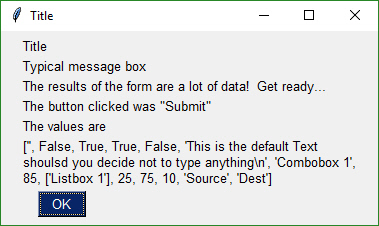
|
|
|
|
|
|
**`Note, button value can be None`**. The value for `button` will be the text that is displayed on the button element when it was created. If the user closed the form using something other than a button, then `button` will be `None`.
|
|
|
|
You can see in the MsgBox that the values returned are a list. Each input field in the form generates one item in the return values list. All input fields return a `string` except for Check Boxes and Radio Buttons. These return `bool`.
|
|
|
|
---
|
|
# Building Custom Forms
|
|
You will find it much easier to write code using PySimpleGUI if you use an IDE such as PyCharm. The features that show you documentation about the API call you are making will help you determine which settings you want to change, if any. In PyCharm, two commands are particularly helpful.
|
|
|
|
Control-Q (when cursor is on function name) brings up a box with the function definition
|
|
Control-P (when cursor inside function call "()") shows a list of parameters and their default values
|
|
|
|
## Synchronous Forms
|
|
The most common use of PySimpleGUI is to display and collect information from the user. The most straightforward way to do this is using a "blocking" GUI call. Execution is "blocked" while waiting for the user to close the GUI form/dialog box.
|
|
You've already seen a number of examples above that use blocking forms. Anytime you see a context manager used (see the `with` statement) it's most likely a blocking form. You can examine the show calls to be sure. If the form is a non-blocking form, it must indicate that in the call to `form.show`.
|
|
|
|
NON-BLOCKING form call:
|
|
|
|
form.Show(non_blocking=True)
|
|
|
|
### Beginning a Form
|
|
The first step is to create the form object using the desired form customization.
|
|
|
|
with FlexForm('Everything bagel', auto_size_text=True, default_element_size=(30,1)) as form:
|
|
|
|
This is the definition of the FlexForm object:
|
|
|
|
def FlexForm(title,
|
|
default_element_size=(DEFAULT_ELEMENT_SIZE[0], DEFAULT_ELEMENT_SIZE[1]),
|
|
auto_size_text=DEFAULT_AUTOSIZE_TEXT,
|
|
scale=(None, None),
|
|
location=(None, None),
|
|
button_color=None,Font=None,
|
|
progress_bar_color=(None,None),
|
|
is_tabbed_form=False,
|
|
border_depth=None,
|
|
auto_close=False,
|
|
auto_close_duration=DEFAULT_AUTOCLOSE_TIME,
|
|
icon=DEFAULT_WINDOW_ICON):
|
|
|
|
Parameter Descriptions. You will find these same parameters specified for each `Element` and some of them in `Row` specifications. The `Element` specified value will take precedence over the `Row` and `Form` values.
|
|
|
|
default_element_size - Size of elements in form in characters (width, height)
|
|
auto_size_text - Bool. True is elements should size themselves according to contents
|
|
scale - Set size of element to be a multiple of the Element size
|
|
location - Location to place window in pixels
|
|
button_color - Default color for buttons (foreground, background). Can be text or hex
|
|
progress_bar_color - Foreground and background colors for progress bars
|
|
is_tabbed_form - Bool. If True then form is a tabbed form
|
|
border_depth - Amount of 'bezel' to put on input boxes, buttons, etc.
|
|
auto_close - Bool. If True form will autoclose
|
|
auto_close_duration - Duration in seconds before form closes
|
|
icon - .ICO file that will appear on the Task Bar and end of Title Bar
|
|
|
|
|
|
#### Sizes
|
|
Note several variables that deal with "size". Element sizes are measured in characters. A Text Element with a size of 20,1 has a size of 20 characters wide by 1 character tall.
|
|
|
|
The default Element size for PySimpleGUI is `(45,1)`.
|
|
|
|
Sizes can be set at the element level, or in this case, the size variables apply to all elements in the form. Setting `size=(20,1)` in the form creation call will set all elements in the form to that size.
|
|
|
|
In addition to `size` there is a `scale` option. `scale` will take the Element's size and scale it up or down depending on the scale value. `scale=(1,1)` doesn't change the Element's size. `scale=(2,1)` will set the Element's size to be twice as wide as the size setting.
|
|
|
|
There are a couple of widgets where one of the size values is in pixels rather than characters. This is true for Progress Meters and Sliders. The second parameter is the 'height' in pixels.
|
|
|
|
|
|
|
|
|
|
#### FlexForm - form-level variables overview
|
|
A summary of the variables that can be changed when a FlexForm is created
|
|
|
|
default_element_size - set default size for all elements in the form
|
|
auto_size_text- true/false autosizing turned on / off
|
|
scale - set scale value for all elements
|
|
button_color- default button color (foreground, background)
|
|
font - font name and size for all text items
|
|
progress_bar_color - progress bar colors
|
|
is_tabbed_form - true/false indicates form is a tabbed or normal form
|
|
border_depth - style setting for buttons, input fields
|
|
auto_close - true/false indicates if form will automatically close
|
|
auto_close_duration - how long in seconds before closing form
|
|
icon - filename for icon that's displayed on the window on taskbar
|
|
|
|
|
|
## Elements
|
|
"Elements" are the building blocks used to create forms. Some GUI APIs use the term Widget to describe these graphic elements.
|
|
|
|
Text
|
|
Single Line Input
|
|
Buttons including these types:
|
|
File Browse
|
|
Folder Browse
|
|
Non-closing return
|
|
Close form
|
|
Checkboxes
|
|
Radio Buttons
|
|
Listbox
|
|
Slider
|
|
Multi-line Text Input
|
|
Scroll-able Output
|
|
Progress Bar
|
|
Async/Non-Blocking Windows
|
|
Tabbed forms
|
|
Persistent Windows
|
|
Redirect Python Output/Errors to scrolling Window
|
|
"Higher level" APIs (e.g. MessageBox, YesNobox, ...)
|
|
|
|
|
|
### Output Elements
|
|
Building a form is simply making lists of Elements. Each list is a row in the overall GUI dialog box. The definition looks something like this:
|
|
|
|
layout = [ [row 1 element, row 1 element],
|
|
[row 2 element, row 2 element, row 2 element] ]
|
|
The code is a crude representation of the GUI, laid out in text.
|
|
#### Text Element
|
|
|
|
layout = [[SG.Text('This is what a Text Element looks like')]]
|
|
|
|
|
|

|
|
|
|
|
|
The most basic element is the Text element. It simply displays text. Many of the 'options' that can be set for a Text element are shared by other elements. Size, Scale are a couple that you will see in every element.
|
|
|
|
Text(Text,
|
|
scale=(None, None),
|
|
size=(None, None),
|
|
auto_size_text=None,
|
|
font=None,
|
|
text_color=None,
|
|
justification=None)
|
|
.
|
|
|
|
Text - The text that's displayed
|
|
size - Element's size
|
|
auto_size_text - Bool. Change width to match size of text
|
|
font - Font name and size to use
|
|
text_color - text color
|
|
justification - Justification for the text. String - 'left', 'right', 'center'
|
|
|
|
Some commonly used elements have 'shorthand' versions of the functions to make the code more compact. The functions `T` and `Txt` are the same as calling `Text`.
|
|
|
|
**Fonts** in PySimpleGUI are always in this format:
|
|
|
|
(font_name, point_size)
|
|
|
|
The default font setting is
|
|
|
|
("Helvetica", 10)
|
|
|
|
**Color** in PySimpleGUI are always in this format:
|
|
|
|
(foreground, background)
|
|
|
|
The values foreground and background can be the color names or the hex value formatted as a string:
|
|
|
|
"#RRGGBB"
|
|
|
|
**auto_size_text**
|
|
A `True` value for `auto_size_text`, when placed on any Element, indicates that the width of the Element should be shrunk do the width of the text. This is particularly useful with `Buttons` as fixed-width buttons are somewhat crude looking. The default value is `False`. You will often see this setting on FlexForm definitions.
|
|
|
|
**Shorthand functions**
|
|
The shorthand functions for `Text` are `Txt` and `T`
|
|
|
|
|
|
#### Multiline Text Element
|
|
|
|
layout = [[SG.Multiline('This is what a Multi-line Text Element looks like', size=(45,5))]]
|
|
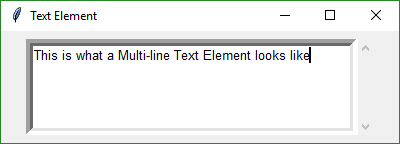
|
|
This Element doubles as both an input and output Element. The `DefaultText` optional parameter is used to indicate what to output to the window.
|
|
|
|
Multiline(default_text='',
|
|
enter_submits = False,
|
|
scale=(None, None),
|
|
size=(None, None),
|
|
auto_size_text=None)
|
|
.
|
|
|
|
default_text - Text to display in the text box
|
|
enter_submits - Bool. If True, pressing Enter key submits form
|
|
scale - Element's scale
|
|
size - Element's size
|
|
auto_size_text - Bool. Change width to match size of text
|
|
|
|
#### Output Element
|
|
Output re-routes `Stdout` to a scrolled text box. It's used with Async forms. More on this later.
|
|
|
|
form.AddRow(gg.Output(size=(100,20)))
|
|
|
|
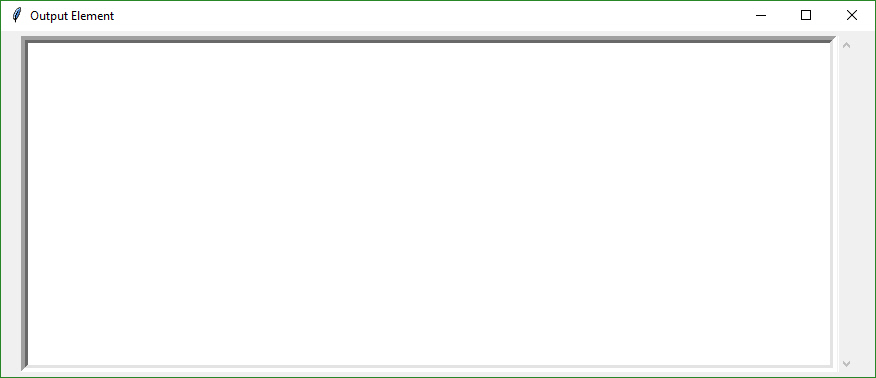
|
|
|
|
Output(scale=(None, None),
|
|
size=(None, None))
|
|
.
|
|
|
|
scale - How much to scale size of element
|
|
size - Size of element (width, height) in characters
|
|
|
|
### Input Elements
|
|
These make up the majority of the form definition. Optional variables at the Element level override the Form level values (e.g. `size` is specified in the Element). All input Elements create an entry in the list of return values. A Text Input Element creates a string in the list of items returned.
|
|
|
|
#### Text Input Element
|
|
|
|
layout = [[SG.InputText('Default text')]]
|
|

|
|
|
|
def InputText(default_text = '',
|
|
scale=(None, None),
|
|
size=(None, None),
|
|
auto_size_text=None,
|
|
password_char='')
|
|
.
|
|
|
|
default_text - Text initially shown in the input box
|
|
scale - Amount size is scaled by
|
|
size - (width, height) of element in characters
|
|
auto_size_text- Bool. True is element should be sized to fit text
|
|
password_char - Character that will be used to replace each entered character. Setting to a value indicates this field is a password entry field
|
|
|
|
Shorthand functions that are equivalent to `InputText` are `Input` and `In`
|
|
|
|
|
|
#### Combo Element
|
|
Also known as a drop-down list. Only required parameter is the list of choices. The return value is a string matching what's visible on the GUI.
|
|
|
|
layout = [[SG.InputCombo(['choice 1', 'choice 2'])]]
|
|
|
|

|
|
|
|
InputCombo(values,
|
|
scale=(None, None),
|
|
size=(None, None),
|
|
auto_size_text=None)
|
|
.
|
|
|
|
values - Choices to be displayed. List of strings
|
|
scale - Amount to scale size by
|
|
size - (width, height) of element in characters
|
|
auto_size_text - Bool. True if size should fit the text length
|
|
|
|
#### Listbox Element
|
|
The standard listbox like you'll find in most GUIs. Note that the return values from this element will be a ***list of results, not a single result***. This is because the user can select more than 1 item from the list (if you set the right mode).
|
|
|
|
layout = [[SG.Listbox(values=['Listbox 1', 'Listbox 2', 'Listbox 3'], size=(30, 6))]]
|
|
|
|
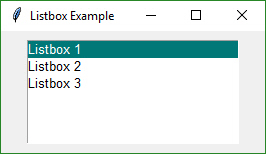
|
|
|
|
|
|
Listbox(values,
|
|
select_mode=None,
|
|
scale=(None, None),
|
|
size=(None, None),
|
|
auto_size_text=None,
|
|
font=None)
|
|
.
|
|
|
|
values - Choices to be displayed. List of strings
|
|
select_mode - Defines how to list is to operate.
|
|
Choices include constants or strings:
|
|
Constants version:
|
|
LISTBOX_SELECT_MODE_BROWSE
|
|
LISTBOX_SELECT_MODE_EXTENDED
|
|
LISTBOX_SELECT_MODE_MULTIPLE
|
|
LISTBOX_SELECT_MODE_SINGLE - the default
|
|
Strings version:
|
|
'browse'
|
|
'extended'
|
|
'multiple'
|
|
'single'
|
|
scale - Amount to scale size by
|
|
size - (width, height) of element in characters
|
|
auto_size_text - Bool. True if size should fit the text length
|
|
|
|
The `select_mode` option can be a string or a constant value defined as a variable. Generally speaking strings are used for these kinds of options.
|
|
|
|
#### Slider Element
|
|
Sliders have a couple of slider-specific settings as well as appearance settings. Examples include the `orientation` and `range` settings.
|
|
|
|
layout = [[SG.Slider(range=(1,500), default_value=222, size=(20,15), orientation='horizontal', font=('Helvetica', 12))]]
|
|
|
|

|
|
|
|
Slider(range=(None,None),
|
|
default_value=None,
|
|
orientation=None,
|
|
border_width=None,
|
|
relief=None,
|
|
scale=(None, None),
|
|
size=(None, None),
|
|
font=None):
|
|
.
|
|
|
|
range - (min, max) slider's range
|
|
default_value - default setting (within range)
|
|
orientation - 'horizontal' or 'vertical' ('h' or 'v' work)
|
|
border_width - how deep the widget looks
|
|
relief - relief style. Values are same as progress meter relief values. Can be a constant or a string:
|
|
RELIEF_RAISED= 'raised'
|
|
RELIEF_SUNKEN= 'sunken'
|
|
RELIEF_FLAT= 'flat'
|
|
RELIEF_RIDGE= 'ridge'
|
|
RELIEF_GROOVE= 'groove'
|
|
RELIEF_SOLID = 'solid'
|
|
scale - Amount to scale size by
|
|
size - (width, height) of element in characters
|
|
auto_size_text - Bool. True if size should fit the text
|
|
|
|
#### Radio Button Element
|
|
Creates one radio button that is assigned to a group of radio buttons. Only 1 of the buttons in the group can be selected at any one time.
|
|
|
|
layout = [[SG.Radio('My first Radio!', "RADIO1", default=True), SG.Radio('My second radio!', "RADIO1")]]
|
|
|
|

|
|
|
|
Radio(text,
|
|
group_id,
|
|
default=False,
|
|
scale=(None, None),
|
|
size=(None, None),
|
|
auto_size_text=None,
|
|
font=None)
|
|
|
|
.
|
|
|
|
text - Text to display next to button
|
|
group_id - Groups together multiple Radio Buttons. Can be any value
|
|
default - Bool. Initial state
|
|
scale - Amount to scale size of element
|
|
size- (width, height) size of element in characters
|
|
auto_size_text - Bool. True if should size width to fit text
|
|
font - Font type and size for text display
|
|
|
|
|
|
#### Checkbox Element
|
|
Checkbox elements are like Radio Button elements. They return a bool indicating whether or not they are checked.
|
|
|
|
layout = [[SG.Checkbox('My first Checkbox!', default=True), SG.Checkbox('My second Checkbox!')]]
|
|
|
|

|
|
|
|
|
|
Checkbox(text,
|
|
default=False,
|
|
scale=(None, None),
|
|
size=(None, None),
|
|
auto_size_text=None,
|
|
font=None):
|
|
.
|
|
|
|
text - Text to display next to checkbox
|
|
default- Bool. Initial state
|
|
scale - Amount to scale size of element
|
|
size - (width, height) size of element in characters
|
|
auto_size_text- Bool. True if should size width to fit text
|
|
font- Font type and size for text display
|
|
|
|
|
|
#### Spin Element
|
|
An up/down spinner control. The valid values are passed in as a list.
|
|
|
|
layout = [[SG.Spin([i for i in range(1,11)], initial_value=1), SG.Text('Volume level')]]
|
|
|
|

|
|
|
|
Spin(values,
|
|
intiial_value=None,
|
|
scale=(None, None),
|
|
size=(None, None),
|
|
auto_size_text=None,
|
|
font=None)
|
|
.
|
|
|
|
values - List of valid values
|
|
initial_value - String with initial value
|
|
scale - Amount to scale size of element
|
|
size - (width, height) size of element in characters
|
|
auto_size_text - Bool. True if should size width to fit text
|
|
font - Font type and size for text display
|
|
|
|
#### Button Element
|
|
Buttons are the most important element of all! They cause the majority of the action to happen. After all, it's a button press that will get you out of a form, whether it but Submit or Cancel, one way or another a button is involved in all forms. The only exception is to this is when the user closes the window using the "X" in the upper corner which means no button was involved.
|
|
|
|
The Types of buttons include:
|
|
* Folder Browse
|
|
* File Browse
|
|
* Close Form
|
|
* Read Form
|
|
|
|
|
|
Close Form - Normal buttons like Submit, Cancel, Yes, No, etc, are "Close Form" buttons. They cause the input values to be read and then the form is closed, returning the values to the caller.
|
|
|
|
Folder Browse - When clicked a folder browse dialog box is opened. The results of the Folder Browse dialog box are written into one of the input fields of the form.
|
|
|
|
File Browse - Same as the Folder Browse except rather than choosing a folder, a single file is chosen.
|
|
|
|
Read Form - This is an async form button that will read a snapshot of all of the input fields, but does not close the form after it's clicked.
|
|
|
|
While it's possible to build forms using the Button Element directly, you should never need to do that. There are pre-made buttons and shortcuts that will make life much easier. The most basic Button element call to use is `SimpleButton`
|
|
|
|
SimpleButton(text,
|
|
scale=(None, None),
|
|
size=(None, None),
|
|
auto_size_text=None,
|
|
button_color=None,
|
|
font=None)
|
|
|
|
Pre-made buttons include:
|
|
|
|
OK
|
|
Ok
|
|
Submit
|
|
Cancel
|
|
Yes
|
|
No
|
|
FileBrowse
|
|
FolderBrowse
|
|
.
|
|
layout = [[SG.OK(), SG.Cancel()]]
|
|
|
|

|
|
|
|
The FileBrowse and FolderBrowse buttons both fill-in values into a text input field somewhere on the form. The location of the TextInput element is specified by the `Target` variable in the function call. The Target is specified using a grid system. The rows in your GUI are numbered starting with 0. The target can be specified as a hard coded grid item or it can be relative to the button.
|
|
|
|
The default value for `Target` is `(ThisRow, -1)`. ThisRow is a special value that tells the GUI to use the same row as the button. The Y-value of -1 means the field one value to the left of the button. For a File or Folder Browse button, the field that it fills are generally to the left of the button is most cases.
|
|
|
|
Let's examine this form as an example:
|
|
|
|
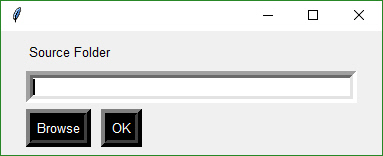
|
|
|
|
The `InputText` element is located at (1,0)... row 1, column 0. The `Browse` button is located at position (2,0). The Target for the button could be any of these values:
|
|
|
|
Target = (1,0)
|
|
Target = (-1,0)
|
|
The code for the entire form could be:
|
|
|
|
layout = [[SG.T('Source Folder')],
|
|
[SG.In()],
|
|
[SG.FolderBrowse(Target=(-1,0)), SG.OK()]]
|
|
|
|
**Custom Buttons**
|
|
If you want to define your own button, you will generally do this with the Button Element `SimpleButton`.
|
|
|
|
layout = [[SG.SimpleButton('My Button')]]
|
|
|
|

|
|
|
|
All buttons can have their text changed by changing the `button_text` variable.
|
|
|
|
**Button Images**
|
|
Now this is an exciting feature not found in many simplified packages.... images on buttons! You can make a pretty spiffy user interface with the help of a few button images.
|
|
|
|
Your button images need to be in PNG or GIF format. When you make a button with an image, set the button background to the same color as the background. There's a button color TRANSPARENT_BUTTON that you can set your button color to.
|
|
|
|
This example comes from the `Demo Media Player.py` example program. Because it's a non-blocking button, it's defined as `ReadFormButton`. You also put images on blocking buttons by using `SimpleButton`.
|
|
|
|
|
|
sg.ReadFormButton('Restart Song', button_color=sg.TRANSPARENT_BUTTON,
|
|
image_filename=image_restart, image_size=(50, 50), image_subsample=2, border_width=0)
|
|
|
|
Three parameters are used for button images.
|
|
|
|
image_filename - Filename. Can be a relative path
|
|
image_size - Size of image file in pixels
|
|
image_subsample - Amount to divide the size by. 2 means your image will be 1/2 the size. 3 means 1/3
|
|
|
|
This is one you'll have to experiment with at this point. Not up for an exhaustive explanation.
|
|
|
|
|
|
**File Types**
|
|
The `FileBrowse` button has an additional setting named `file_types`. This variable is used to filter the files shown in the file dialog box. The default value for this setting is
|
|
|
|
FileTypes=(("ALL Files", "*.*"),)
|
|
|
|
This code produces a form where the Browse button only shows files of type .TXT
|
|
|
|
layout = [[SG.In() ,SG.FileBrowse(file_types=(("Text Files", "*.txt"),))]]
|
|
|
|
***The ENTER key***
|
|
The ENTER key is an important part of data entry for forms. There's a long tradition of the enter key being used to quickly submit forms. PySimpleGUI implements this by tying the ENTER key to the first button that closes or reads a form. If there are more than 1 button on a form, the FIRST button that is of type Close Form or Read Form is used. First is determined by scanning the form, top to bottom and left to right.
|
|
|
|
|
|
---
|
|
#### ProgressBar
|
|
The `ProgressBar` element is used to build custom Progress Bar forms. It is HIGHLY recommended that you use the functions that provide a complete progress meter solution for you. Progress Meters are not easy to work with because the forms have to be non-blocking and they are tricky to debug.
|
|
|
|
The **easiest** way to get progress meters into your code is to use the `EasyProgessMeter` API. This consists of a pair of functions, `EasyProgessMeter` and `EasyProgressMeterCancel`. You can easily cancel any progress meter by calling it with the current value = max value. This will mark the meter as expired and close the window.
|
|
You've already seen EasyProgressMeter calls presented earlier in this readme.
|
|
|
|
SG.EasyProgressMeter('My Meter', i+1, 1000, 'Optional message')
|
|
|
|
The return value for `EasyProgressMeter` is:
|
|
`True` if meter updated correctly
|
|
`False` if user clicked the Cancel button, closed the form, or vale reached the max value.
|
|
**Customized Progress Bar**
|
|
If you want a bit more customization of your meter, then you can go up 1 level and use the calls to `ProgressMeter` and `ProgressMeterUpdate`. These APIs behave like an object we're all used to. First you create the `ProgressMeter` object, then you call the `Update` method to update it.
|
|
|
|
You setup the progress meter by calling
|
|
|
|
my_meter = ProgressMeter(title,
|
|
max_value,
|
|
*args,
|
|
orientantion=None,
|
|
bar_color=DEFAULT_PROGRESS_BAR_COLOR,
|
|
button_color=None,
|
|
size=DEFAULT_PROGRESS_BAR_SIZE,
|
|
scale=(None, None),
|
|
border_width=DEFAULT_PROGRESS_BAR_BORDER_WIDTH)
|
|
Then to update the bar within your loop
|
|
|
|
return_code = ProgressMeterUpdate(my_meter,
|
|
value,
|
|
*args):
|
|
Putting it all together you get this design pattern
|
|
|
|
my_meter = SG.ProgressMeter('Meter Title', 100000, orentation='Vert')
|
|
|
|
for i in range(0, 100000):
|
|
SG.ProgressMeterUpdate(my_meter, i+1, 'Some variable', 'Another variable')
|
|
|
|
|
|
The final way of using a Progress Meter with PySimpleGUI is to build a custom form with a `ProgressBar` Element in the form. You will need to run your form as a non-blocking form. When you are ready to update your progress bar, you call the `UpdateBar` method for the `ProgressBar` element itself.
|
|
|
|
|
|
#### Output
|
|
The Output Element is a re-direction of Stdout. Anything "printed" will be displayed in this element.
|
|
|
|
Output(scale=(None, None),
|
|
size=(None, None))
|
|
|
|
Here's a complete solution for a chat-window using an Async form with an Output Element
|
|
|
|
import PySimpleGUI as SG
|
|
# Blocking form that doesn't close
|
|
def ChatBot():
|
|
with SG.FlexForm('Chat Window', auto_size_text=True, default_element_size=(30, 2)) as form:
|
|
layout = [[(SG.Text('This is where standard out is being routed', size=[40, 1]))],
|
|
[SG.Output(size=(80, 20))],
|
|
[SG.Multiline(size=(70, 5), enter_submits=True), SG.ReadFormButton('SEND', button_color=(SG.YELLOWS[0], SG.BLUES[0])), SG.SimpleButton('EXIT', button_color=(SG.YELLOWS[0], SG.GREENS[0]))]]
|
|
# notice this is NOT the usual LayoutAndRead call because you don't yet want to read the form
|
|
# if you call LayoutAndRead from here, then you will miss the first button click
|
|
form.Layout(layout)
|
|
# ---===--- Loop taking in user input and using it to query HowDoI web oracle --- #
|
|
while True:
|
|
button, value = form.Read()
|
|
if button == 'SEND':
|
|
print(value)
|
|
else:
|
|
break
|
|
|
|
|
|
## Tabbed Forms
|
|
Tabbed forms are shown using the `ShowTabbedForm` call. The call has the format
|
|
|
|
results = ShowTabbedForm('Title for the form',
|
|
(form,layout,'Tab 1 label'),
|
|
(form2,layout2, 'Tab 2 label'))
|
|
|
|
Each of the tabs of the form is in fact a form. The same steps are taken to create the form as before. A `FlexForm` is created, then rows are filled with Elements, and finally the form is shown. When calling `ShowTabbedForm`, each form is passed in as a tuple. The tuple has the format: `(the form, the rows, a label shown on the tab)`
|
|
|
|
## Global Settings
|
|
**Global Settings**
|
|
Let's have some fun customizing! Make PySimpleGUI look the way you want it to look. You can set the global settings using the function `PySimpleGUI.SetOptions`. Each option has an optional parameter that's used to set it.
|
|
|
|
SetOptions(icon=None,
|
|
button_color=(None,None),
|
|
element_size=(None,None),
|
|
margins=(None,None),
|
|
element_padding=(None,None),
|
|
auto_size_text=None,
|
|
font=None,
|
|
border_width=None,
|
|
slider_border_width=None,
|
|
slider_relief=None,
|
|
slider_orientation=None,
|
|
autoclose_time=None,
|
|
message_box_line_width=None,
|
|
progress_meter_border_depth=None,
|
|
text_justification=None,
|
|
debug_win_size=(None,None):
|
|
|
|
Explanation of parameters
|
|
|
|
icon - filename of icon used for taskbar and title bar
|
|
button_color - button color (foreground, background)
|
|
element_size - element size (width, height) in characters
|
|
margins - tkinter margins around outsize
|
|
element_padding - tkinter padding around each element
|
|
auto_size_text - autosize the elements to fit their text
|
|
font - font used for elements
|
|
border_width - amount of bezel or border around sunken or raised elements
|
|
slider_border_width - changes the way sliders look
|
|
slider_relief - changes the way sliders look
|
|
slider_orientation - changes orientation of slider
|
|
autoclose_time - time in seconds for autoclose boxes
|
|
message_box_line_width - number of characers in a line of text in message boxes
|
|
progress_meter_border_depth - amount of border around raised or lowered progress meters
|
|
text_justification - justification to use on Text Elements. Values are strings - 'left', 'right', 'center'
|
|
debug_win_size - size of the Print output window
|
|
|
|
|
|
These settings apply to all forms `SetOptions`. The Row options and Element options will take precedence over these settings. Settings can be thought of as levels of settings with the Form-level being the highest and the Element-level the lowest. Thus the levels are:
|
|
|
|
- Form level
|
|
- Row level
|
|
- Element level
|
|
|
|
Each lower level overrides the settings of the higher level
|
|
|
|
## Asynchronous (Non-Blocking) Forms
|
|
So you want to be a wizard do ya? Well go boldly! While the majority of GUIs are a simple exercise to "collect input values and return with them", there are instances where we want to continue executing while the form is open. These are "asynchronous" forms and require special options, new SDK calls, and **great care**. With asynchronous forms the form is shown, user input is read, but your code keeps right on chugging. YOUR responsibility is to call `PySimpleGUI.ReadNonBlocking` on a periodic basis. Once a second or more will produce a reasonably snappy GUI.
|
|
|
|
When do you use a non-blocking form? A couple of examples are
|
|
* A media file player like an MP3 player
|
|
* A status dashboard that's periodically updated
|
|
* Progress Meters - when you want to make your own progress meters
|
|
* Output using print to a scrolled text element. Good for debugging.
|
|
|
|
Word of warning... version 2.2, the currently released, and upcoming version 2.3 differ in the return code for the `ReadNonBlocking` call. Previously the function returned 2 values, except when the form is closed using the "X" which returned a single value of `None`. The *new* way is that `ReadNonBlocking` always returns 2 values. If the user closed the form with the "X" then the return values will be None, None. You will want to key off the second value to catch this case.
|
|
The proper code to check if the user has exited the form will be a polling-loop that looks something like this:
|
|
|
|
while True:
|
|
button, values = form.ReadNonBlocking()
|
|
if values is None or button == 'Quit':
|
|
break
|
|
|
|
We're going to build an app that does the latter. It's going to update our form with a running clock.
|
|
|
|
The basic flow and functions you will be calling are:
|
|
Setup
|
|
|
|
|
|
form = FlexForm()
|
|
form_rows = .....
|
|
form.LayoutAndRead(form_rows, non_blocking=True)
|
|
|
|
|
|
Periodic refresh
|
|
|
|
form.ReadNonBlocking()
|
|
If you need to close the form
|
|
|
|
form.CloseNonBlockingForm()
|
|
|
|
Rather than the usual `form.LayoutAndRead()` call, we're manually adding the rows (doing the layout) and then showing the form. After the form is shown, you simply call `form.ReadNonBlocking()` every now and then.
|
|
|
|
When you are ready to close the form (assuming the form wasn't closed by the user or a button click) you simply call `form.CloseNonBlockingForm()`
|
|
|
|
**Example - Running timer that updates**
|
|
See the sample code on the GitHub named Demo Media Player for another example of Async Forms. We're going to make a form and update one of the elements of that form every .01 seconds. Here's the entire code to do that.
|
|
|
|
|
|
import PySimpleGUI as sg
|
|
import time
|
|
|
|
# form that doesn't block
|
|
# Make a form, but don't use context manager
|
|
form = sg.FlexForm('Running Timer', auto_size_text=True)
|
|
# Create a text element that will be updated with status information on the GUI itself
|
|
output_element = sg.Text('', size=(8, 2), font=('Helvetica', 20))
|
|
# Create the rows
|
|
form_rows = [[sg.Text('Non-blocking GUI with updates')],
|
|
[output_element],
|
|
[sg.SimpleButton('Quit')]]
|
|
# Layout the rows of the form and perform a read. Indicate the form is non-blocking!
|
|
form.LayoutAndRead(form_rows, non_blocking=True)
|
|
|
|
#
|
|
# Some place later in your code...
|
|
# You need to perform a ReadNonBlocking on your form every now and then or
|
|
# else it won't refresh
|
|
#
|
|
|
|
for i in range(1, 1000):
|
|
output_element.Update('{:02d}:{:02d}.{:02d}'.format(*divmod(int(i / 100), 60), i % 100))
|
|
button, values = form.ReadNonBlocking()
|
|
if values is None or button == 'Quit':
|
|
break
|
|
time.sleep(.01)
|
|
else:
|
|
form.CloseNonBlockingForm()
|
|
|
|
|
|
|
|
What we have here is the same sequence of function calls as in the description. Get a form, add rows to it, show the form, and then refresh it every now and then.
|
|
|
|
The new thing in this example is the call use of the Update method for the Text Element. The first thing we do inside the loop is "update" the text element that we made earlier. This changes the value of the text field on the form. The new value will be displayed when `form.ReadNonBlocking()` is called.
|
|
|
|
Note the `else` statement on the for loop. This is needed because we're about to exit the loop while the form is still open. The user has not closed the form using the X nor a button so it's up to the caller to close the form using `CloseNonBlockingForm`.
|
|
|
|
That's it... this example follows the async design pattern well.
|
|
|
|
|
|
|
|
## Sample Applications
|
|
Use the example programs as a starting basis for your GUI. Copy, paste, modify and run! The demo files are:
|
|
|
|
`Demo DisplayHash1and256.py` - Demonstrates using High Level API calls to get a filename
|
|
|
|
`Demo DupliucateFileFinder.py` - Demonstrates High Level API to get a folder & Easy Progress Meter to show progress of the file scanning
|
|
|
|
`Demo Recipes.py` - Three sample forms including an asynchronous form
|
|
|
|
`Demo HowDoI.py` - An amazing little application. Acts as a front-end to HowDoI. This one program could forever change how you code. It does searches on Stack Overflow and returns the CODE found in the best answer for your query.
|
|
|
|
## Fun Stuff
|
|
Here are some things to try if you're bored or want to further customize
|
|
|
|
**Random colors**
|
|
To set a button or text to a random color, use the string `'random'` as the color value. You can also call `PySimpleGUI.GetRandomColor`.
|
|
To get a random color pair call `PySimpleGUI.GetRandomColorPair`. This returns a tuple containing a random color and
|
|
that color's compliment.
|
|
sprint
|
|
|
|
**Debug Output**
|
|
Be sure and check out the EasyPrint (Print) function described in the high-level API section. Leave your code the way it is, route your stdout and stderror to a scrolling window.
|
|
|
|
For a fun time, add this line to the top of your script
|
|
|
|
import PySimpleGUI as sg
|
|
print = sg.Print
|
|
|
|
|
|
**Look and Feel**
|
|
Dial in the look and feel that you like with the `SetOptions` function. You can change all of the defaults in one function call. One line of code to customize the entire GUI.
|
|
|
|
**ObjToString**
|
|
Ever wanted to easily display an objects contents easily? Use ObjToString to get a nicely formatted recursive walk of your objects.
|
|
This statement:
|
|
|
|
print(sg.ObjToSting(x))
|
|
|
|
And this was the output
|
|
|
|
<class '__main__.X'>
|
|
abc = abc
|
|
attr12 = 12
|
|
c = <class '__main__.C'>
|
|
b = <class '__main__.B'>
|
|
a = <class '__main__.A'>
|
|
attr1 = 1
|
|
attr2 = 2
|
|
attr3 = three
|
|
attr10 = 10
|
|
attrx = x
|
|
|
|
You'll quickly wonder how you ever coded without it.
|
|
|
|
|
|
|
|
|
|
---
|
|
# Known Issues
|
|
While not an "issue" this is a ***stern warning***
|
|
|
|
## **Do not attempt** to call `PySimpleGUI` from multiple threads! It's `tkinter` based and `tkinter` has issues with multiple threads
|
|
|
|
**Progress Meters** - the visual graphic portion of the meter may be off. May return to the native tkinter progress meter solution in the future. Right now a "custom" progress meter is used. On the bright side, the statistics shown are extremely accurate and can tell you something about the performance of your code.
|
|
|
|
**Async Forms** - these include the 'easy' forms (EasyProgressMeter and EasyPrint/Print). If you start overlapping having Async forms open with normal forms then things get a littler squirrelly. Still tracking down the issues and am making it more solid every day possible. You'll know there's an issue when you see blank form.
|
|
|
|
**EasyPrint** - EasyPrint is a new feature that's pretty awesome. You print and the output goes to a window, with a scroll bar, that you can copy and paste from. Being a new feature, it's got some potential problems. There are known interaction problems with other GUI windows. For example, closing a Print window can also close other windows you have open. For now, don't close your debug print window until other windows are closed too.
|
|
|
|
## Contributing
|
|
|
|
A MikeTheWatchGuy production... entirely responsible for this code.... unless it causes you trouble in which case I'm not at all responsible.
|
|
|
|
## Versions
|
|
|Version | Description |
|
|
|--|--|
|
|
| 1.0.9 | July 10, 2018 - Initial Release |
|
|
| 1.0.21 | July 13, 2018 - Readme updates |
|
|
| 2.0.0 | July 16, 2018 - ALL optional parameters renamed from CamelCase to all_lower_case
|
|
| 2.1.1 | July 18, 2018 - Global settings exposed, fixes
|
|
| 2.2.0| July 20, 2018 - Image Elements, Print output
|
|
| 2.3.0 | July 23, 2018 - Changed form.Read return codes, Slider Elements, Listbox element. Renamed some methods but left legacy calls in place for now.
|
|
| 2.4.0 | July 24, 2018 - Button images. Fixes so can run on Raspberry Pi
|
|
|
|
### Release Notes
|
|
2.3 - Sliders, Listbox's and Image elements (oh my!)
|
|
|
|
If using Progress Meters, avoid cancelling them when you have another window open. It could lead to future windows being blank. It's being worked on.
|
|
|
|
New debug printing capability. `sg.Print`
|
|
|
|
### Upcoming
|
|
Make suggestions people! Future release features
|
|
|
|
Columns. How multiple columns would be specified in the SDK interface are still being designed.
|
|
|
|
Progress Meters - Replace custom meter with tkinter meter.
|
|
|
|
|
|
## Code Condition
|
|
|
|
Make it run
|
|
Make it right
|
|
Make it fast
|
|
|
|
It's a recipe for success if done right. PySimpleGUI has completed the "Make it run" phase. It's far from "right" in many ways. These are being worked on. The module is particularly poor for PEP 8 compliance. It was a learning exercise that turned into a somewhat complete GUI solution for lightweight problems.
|
|
|
|
While the internals to PySimpleGUI are a tad sketchy, the public interfaces into the SDK are more strictly defined and comply with PEP 8 for the most part.
|
|
|
|
Please log bugs and suggestions in the GitHub! It will only make the code stronger and better in the end, a good thing for us all, right?
|
|
|
|
## Authors
|
|
MikeTheWatchGuy
|
|
|
|
## License
|
|
|
|
GNU Lesser General Public License (LGPL 3)
|
|
|
|
## Acknowledgments
|
|
|
|
* Jorj McKie was the motivator behind the entire project. His wxsimpleGUI concepts sparked PySimpleGUI into existence
|
|
|
|
## How Do I
|
|
Finally, I must thank the fine folks at How Do I.
|
|
https://github.com/gleitz/howdoi
|
|
Their utility has forever changed the way and pace in which I can program. I urge you to try the HowDoI.py application here on GitHub. Trust me, **it's going to be worth the effort!**
|
|
Here are the steps to run that application
|
|
|
|
Install howdoi:
|
|
pip install howdoi
|
|
Test your install:
|
|
python -m howdoi howdoi.py
|
|
To run it:
|
|
Python HowDoI.py
|
|
|
|
The pip command is all there is to the setup.
|
|
|
|
The way HowDoI works is that it uses your search term to look through stack overflow posts. It finds the best answer, gets the code from the answer, and presents it as a response. It gives you the correct answer OFTEN. It's a miracle that it work SO well.
|
|
For Python questions, I simply start my query with 'Python'. Let's say you forgot how to reverse a list in Python. When you run HowDoI and ask this question, this is what you'll see.
|
|
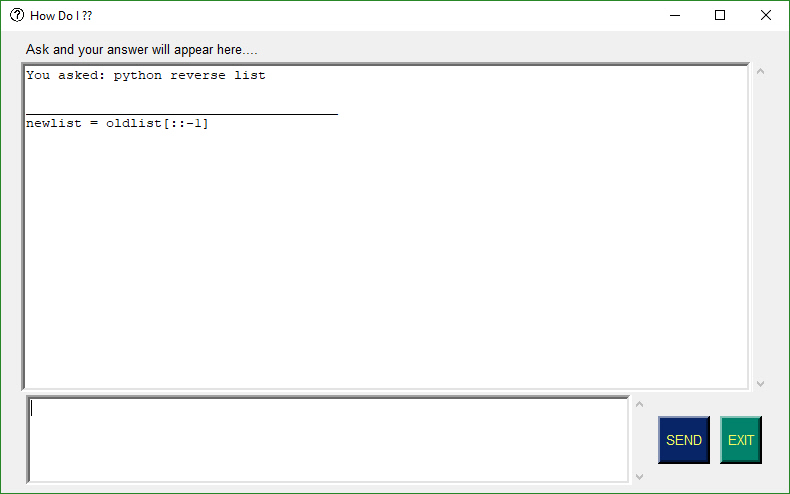
|
|
|
|
In the hands of a competent programmer, this tool is **amazing**. It's a must-try kind of program that has completely changed my programming process. I'm not afraid of asking for help! You just have to be smart about using what you find.
|
|
|
|
The PySimpleGUI window that the results are shown in is an 'input' field which means you can copy and paste the results right into your code.
|